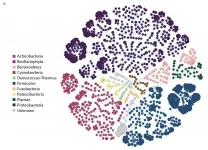(Press-News.org) Kittens could be the model for understanding infectious, sometimes deadly, diarrheal disease in both animals and children, according to new research from North Carolina State University.
Diarrheagenic Escherichia coli (DEC) bacteria cause lethal diarrheal disease in children worldwide, killing up to 120,000 children under the age of five annually. Atypical enteropathic Escherichia coli (aEPEC) are a form of DEC increasingly associated with diarrheal disease in humans and in kittens.
"We were looking for causes of infectious diarrhea in kittens, which has a high mortality rate, and came across this pathogen," says Jody Gookin, FluoroScience Distinguished Professor in Veterinary Scholars Research Education at NC State and corresponding author of the research.
"The interesting thing about aEPEC is that you can find it in both healthy and sick individuals. Having it in your intestinal tract doesn't mean you're sick, but those that are sick have a higher burden, or amount of the bacteria, in their bodies."
Gookin and Victoria Watson, a former Ph.D. student at NC State and lead author of the study, performed a genomic analysis of aEPEC isolates from both healthy kittens who were colonized by the bacteria and kittens with lethal infections to try and determine why aEPEC causes illness in some kittens but remains dormant in others.
With collaborators at the University of Maryland, Gookin and Watson then compared the genomic data from both groups of kittens to human aEPEC isolates. However, there were no specific genetic markers that allowed the researchers to distinguish between the groups of isolates.
"The aEPEC isolated from humans is the same as that found in healthy and sick kittens," Gookin says. "There weren't any unique genetic markers that could explain why one group of bacteria causes disease while the other one doesn't. The only thing we found were behavioral differences between the isolate groups.
"The pathogenic, or disease-causing, isolates had more motility - they were better swimmers. AEPEC bacteria cause disease by attaching to epithelial cells lining the intestine. Those cells then secrete fluids, causing diarrhea. So the better or further aEPEC bacteria could swim, the easier it would be to find cells and attach."
The findings point to kittens as a potentially invaluable model for further exploration of aEPEC on the molecular level to inform treatment approaches for both humans and felines.
"This is the first report of the genetics being the same in groups of aEPEC isolates from humans and kittens, both healthy and sick," Gookin says. "It is also further evidence that our companion animals can give us important insights into diseases that affect us both."
INFORMATION:
The work appears in Infection and Immunity and was supported by the Winn Feline Foundation (grant W14-035) and the National Institutes of Health (grants U19AI110820 and T32OD011130). Watson is a veterinary pathologist currently at Michigan State University. Tracy Hazen and David Rasko from the University of Maryland School of Medicine also contributed to the work.
Note to editors: An abstract follows.
"Comparative Genomics of Atypical Enteropathogenic Escherichia coli from Kittens and Children Identifies Bacterial Factors Associated with Virulence in Kittens"
DOI: 10.1128/IAI.00619-20
Authors: Victoria E. Watson, Megan E. Jacob, Johanna R. Elfenbein, Stephen H. Stauffer, Jody L. Gookin, North Carolina State University; Tracy H. Hazen, David A. Rasko, University of Maryland
Published: Feb. 16, 2021 in Infection and Immunity
Abstract:
Typical enteropathogenic Escherichia coli (tEPEC) is a leading cause of diarrhea and associated death in children worldwide. Atypical EPEC (aEPEC) lacks the plasmid encoding bundle-forming pili and is considered less virulent, but the molecular mechanism of virulence is poorly understood. We recently identified kittens as a host for aEPEC where intestinal epithelial colonization was associated with diarrheal disease and death. The purposes of this study were to (i) determine the genomic similarity between kitten aEPEC and human aEPEC isolates and (ii) identify genotypic or phenotypic traits associated with virulence in kitten aEPEC. We observed no differences between kitten and human aEPEC in core genome content or gene cluster sequence identities, and no distinguishing genomic content was observed between aEPEC isolates from kittens with nonclinical colonization (NC) versus those with lethal infection (LI). Variation in adherence patterns and ability to aggregate actin in cultured cells mirrored descriptions of human aEPEC. The aEPEC isolated from kittens with LI were significantly more motile than isolates from kittens with NC. Kittens may serve as a reservoir for aEPEC that is indistinguishable from human aEPEC isolates and may provide a needed comparative animal model for the study of aEPEC pathogenesis. Motility seems to be an important factor in pathogenesis of LI associated with aEPEC in kittens.
Building upon previous research, an international team led by scientists at University of California San Diego School of Medicine, has validated a more inclusive and comprehensive genetic tool for predicting age of onset of aggressive prostate cancer, a disease that killed more than 33,000 American men in 2020.
Reporting in the February 23, 2021 online edition of Nature Communications, the researchers describe the performance of a polygenic hazard score (PHS) -- a mathematical estimate of an individuals' age-specific genetic risk for developing a disease -- in a multi-ethnic patient population.
"Genetic tools to predict a man's lifetime risk of prostate cancer might allow us to target cancer screening efforts to the men who are most likely to need it. We are ...
MINNEAPOLIS/ST.PAUL (02/23/2021) -- University of Minnesota Medical School researchers have developed two new rapid diagnostic tests for COVID-19 - one to detect COVID-19 variants and one to help differentiate with other illnesses that have COVID-19-like symptoms. The findings were recently published in the journal Bioengineering.
Although many people are hopeful about COVID-19 vaccines, widespread vaccine distribution isn't predicted to be available until several months from now. Until that happens, the ability to diagnose COVID-19 quickly and accurately is crucial to help minimize loss of life and ...
Shipping traffic can be a major source of tiny plastic particles floating in the sea, especially out in the open ocean. In a paper published in the scientific journal Environmental Science & Technology, a team of German environmental geochemists based at the University of Oldenburg's Institute of Chemistry and Biology of the Marine Environment and led by Dr Barbara Scholz-Boettcher for the first time provides an overview of microplastics mass distribution in the North Sea.
The scientists found that most of the plastic particles in water samples taken from the German Bight, an area in the south-eastern corner of the North Sea which encompasses some of the world's busiest shipping lanes, originate from binders used in marine paints. "Our hypothesis is that ships leave ...
A recommendation for more intensive blood pressure management from an influential global nonprofit that publishes clinical practice guidelines in kidney disease could, if followed, benefit nearly 25 million Americans, according to an analysis led by researchers at the Johns Hopkins Bloomberg School of Public Health.
The new recommendation from Kidney Disease: Improving Global Outcomes, a global nonprofit that develops evidence-based clinical practice guidelines in kidney disease, is aimed at doctors to help them to reduce blood pressure for chronic kidney disease patients whose systolic blood pressure levels are over 120 mmHg. Blood pressure can be reduced using antihypertensive medications and lifestyle modifications. ...
Multi-ethnic neighborhoods in England retain their diversity and are much more stable than such neighborhoods in the U.S., according to geographers from the U.S. and U.K. The team examined how neighborhood diversity has changed on a national scale from 1991 to 2011 using U.K. Census data.
Past studies of this kind have often focused on neighborhoods in which the presence of two or three different ethnic groups constituted a diverse neighborhood but this study applied a more rigorous standard. A multi-ethnic neighborhood had to have at least five or more ethnic groups represented and no group could represent more ...
The cocktail of beneficial bacteria passed from mother to infant through breast milk changes significantly over time and could act like a daily booster shot for infant immunity and metabolism. The research, conducted by scientists from Montreal and Guatemala and published in Frontiers in Microbiology, has important implications for infant development and health.
Researchers discovered a range of microbiome species never before identified in human milk. Until now, relatively little was known about the role microbiome bacteria play in breast milk. These bacteria are thought to protect the infant gastrointestinal tract and improve aspects of long-term health, such as allergy ...
A toxin produced by bacteria as a defence mechanism causes mutations in target bacteria that could help them survive, according to a study published today in eLife.
The finding suggests that competitive encounters between bacterial cells could have profound consequences on the evolution of bacterial populations.
When bacterial cells come into contact, they often produce toxins as a defence mechanism. Although it is known that the bacteria producing these toxins have a competitive advantage, exactly how the toxins affect the recipient cells is less clear.
"Undergoing intoxication is not always detrimental for cells - there are scenarios in which encountering a toxin could provide a benefit, such as generating antibiotic ...
To combat climate change, shifting from fossil fuels to clean and sustainable energy sources is imperative. A popular candidate in this regard is hydrogen, an eco-friendly fuel that produces only water when used. However, the efficient methods of hydrogen production are usually not eco-friendly. The eco-friendly alternative of splitting water with sunlight to produce hydrogen is inefficient and suffers from low stability of the photocatalyst (material that facilitates chemical reactions by absorbing light). How does one address the issue of developing a stable and efficient photocatalyst?
In a study recently published in Applied Catalysis B: Environmental, ...
Having a memory of past events enables us to take smarter decisions about the future. Researchers at the Max-Planck Institute for Dynamics and Self-Organization (MPI-DS) and the Technical University of Munich (TUM) have now identified how the slime mold Physarum polycephalum saves memories - although it has no nervous system.
The ability to store and recover information gives an organism a clear advantage when searching for food or avoiding harmful environments. Traditionally it has been attributed to organisms that have a nervous system.
A new study authored by Mirna Kramar (MPI-DS) and Prof. Karen Alim (TUM and MPI-DS) challenges this view by uncovering the surprising abilities of a highly dynamic, single-celled organism to store and ...
During ice ages, the global mean sea level falls because large amounts sea water are stored in the form of huge continental glaciers. Until now, mathematical models of the last ice age could not reconcile the height of the sea level and the thickness of the glacier masses: the so-called Missing Ice Problem. With new calculations that take into account crustal, gravitational and rotational perturbation of the solid Earth, an international team of climate researchers has succeeded in resolving the discrepancy, among them Dr. Paolo Stocchi from the Royal Netherlands Institute for Sea Research (NIOZ). The study, now published in the ...



